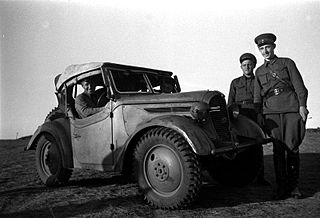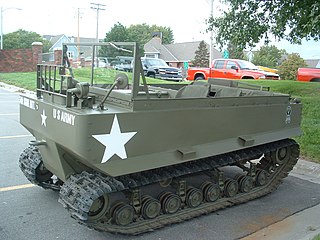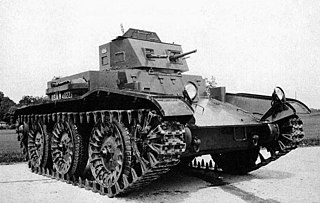
Jeep is an American automobile marque, now owned by multi-national corporation Stellantis. Jeep has been part of Chrysler since 1987, when Chrysler acquired the Jeep brand, along with other assets, from their previous owner American Motors Corporation (AMC).

The Volkswagen Type 82 Kübelwagen, or simply Kübel, contractions of the original German word Kübelsitzwagen, is a military light utility vehicle designed by Ferdinand Porsche and built by Volkswagen during World War II for use by the Nazi German military. Based heavily on the Volkswagen Beetle, it was prototyped and first deployed in Poland as the Type 62, but following improvements entered full-scale production as the Type 82. Several derivative models, such as the Kommandeurswagen, were also built in hundreds, or in dozens.

The BT tanks were a series of Soviet light tanks produced in large numbers between 1932 and 1941. They were lightly armoured, but reasonably well-armed for their time, and had the best mobility of all contemporary tanks. The BT tanks were known by the nickname Betka from the acronym, or its diminutive Betushka. The successor of the BT tanks was the famous T-34 medium tank, introduced in 1940, which would replace all of the Soviet fast tanks, infantry tanks, and medium tanks in service.

Four-wheel drive, also called 4×4 or 4WD, refers to a two-axled vehicle drivetrain capable of providing torque to all of its wheels simultaneously. It may be full-time or on-demand, and is typically linked via a transfer case providing an additional output drive shaft and, in many instances, additional gear ranges.

A half-track is a civilian or military vehicle with regular wheels at the front for steering and continuous tracks at the back to propel the vehicle and carry most of the load. The purpose of this combination is to produce a vehicle with the cross-country capabilities of a tank and the handling of a wheeled vehicle.

A drive wheel is a wheel of a motor vehicle that transmits force, transforming torque into tractive force from the tires to the road, causing the vehicle to move. The powertrain delivers enough torque to the wheel to overcome stationary forces, resulting in the vehicle moving forwards or backwards.

The Light Tank Mark I to Mark V were a series of related designs of light tank produced by Vickers for the British Army during the interwar period.

The Type 95 was a Japanese scout car built by Tokyu Kurogane Industries, and was used during the war with China and World War II in the East. Between 1936 and 1944 approximately 4,700 were built. It was the only completely Japanese designed reconnaissance car ever used by the Imperial Japanese Army, which tended to use civilian cars. Its nickname is the "Yonki" (よんき) which in Japanese means "all-wheel drive". In the field, soldiers often called it the "daruma" after the Buddhist symbol for good luck.

The Marmon-Herrington Armoured Car was a series of armoured vehicles that were produced in South Africa and adopted by the British Army during the Second World War. RAF Armoured Car companies possessed them, but seem never to have used them in action, making greater use of Rolls-Royce Armoured Cars and other types.

The BA-64 was a Soviet four-wheeled armoured scout car. Built on the chassis of a GAZ-64 or GAZ-67 jeep, it incorporated a hull loosely modeled after that of the Sd.Kfz. 221. The BA-64 was developed between July and November 1941 to replace the BA-20 then in service with armoured car units of the Red Army. Cheap and exceptionally reliable, it would later become the most common Soviet wheeled armoured fighting vehicle to enter service during World War II, with over 9,000 being manufactured before production ended.

BTR-90 (GAZ-5923) is an 8×8 wheeled armored personnel carrier developed in Russia, designed in 1993 and first shown publicly in 1994. It is a larger version of the BTR-80 vehicle, fitted with a BMP-2 turret.

The M29 Weasel is a World War II tracked vehicle designed for operation in snow. Built by Studebaker, Weasels were also used in sandy, muddy, and desert terrains, including towing loads over terrain wheeled vehicles could not negotiate as in the U.S. Marine invasions of Iwo Jima and Okinawa.

The Willys MB and the Ford GPW, both formally called the U.S. Army Truck, 1⁄4‑ton, 4×4, Command Reconnaissance, commonly known as the Willys Jeep, Jeep, or jeep, and sometimes referred to by its Standard Army vehicle supply nr. G-503, were highly successful American off-road capable, light military utility vehicles. Well over 600,000 were built to a single standardized design, for the United States and the Allied forces in World War II, from 1941 until 1945. This also made it the world's first mass-produced four-wheel drive car, built in six-figure numbers.

The WZ-551 is a Chinese wheeled infantry fighting vehicle family. The name WZ-551 actually covers two families of vehicles with the official designations in the People's Liberation Army (PLA) – Type 90 and Type 92. Over 3,000 WZ-551s are in service with the PLA, where they are used by medium mechanized infantry units.

The M59 was an American armored personnel carrier that entered service in the spring of 1954 replacing the M75. It had three key advantages over the M75: it was amphibious, had a lower profile, and was considerably cheaper to produce. Production ended in 1960, by which time approximately 6,300 had been built. The M84 Mortar Carrier was a derivative of the M59. The M59 was replaced in service by the M113 family of vehicles.

Military light utility vehicle, or simply light utility vehicle (LUV), is a term used for the lightest weight class military vehicle category. A Jeep-like four-wheel drive vehicle for military use by definition lighter than other military trucks and vehicles, inherently compact and usually with light or no armour, with short body overhangs for nimble all-terrain mobility, and frequently around 4-passenger capacity.

Canadian Military Pattern (CMP) trucks were mutually coherent ranges of military trucks, made in large numbers, in several classes and numerous versions, by Canada's branches of the U.S. 'Big Three' auto-makers during World War II, compliant to British Army specifications, primarily intended for use in the armies of the British Commonwealth allies, but also serving in other units of the British Empire.

The Dodge WC series is a prolific range of light 4WD and medium 6WD military utility trucks, produced by Chrysler under the Dodge and Fargo marques during World War II. Together with the 1⁄4-ton jeeps produced by Willys and Ford, the Dodge 1⁄2‑ton G-505 and 3⁄4‑ton G-502 trucks made up nearly all of the light 4WD trucks supplied to the U.S. military in WWII – with Dodge contributing some 337,500 4WD units.

T7 Combat Car was a prototype United States light tank design of the interwar period. It could run on rubber-tired wheels on roads or mount tracks for cross-country use. Although adequate in some areas, it lacked armament compared to contemporary vehicles and the project was cancelled after only one was built.
The Vickers Medium Dragon was a fully-tracked British field artillery tractor made by Vickers, produced in various versions from 1922 to 1937. The Medium Dragon towed a wide range of artillery, from 18-pounder field guns to BL 60-pounder heavy field guns. It was developed from the carrier version of a 'Tropical Tank' designed by Lt-Colonel Philip Johnson, using components from the running gear of the Vickers Medium Mark I tank.




















